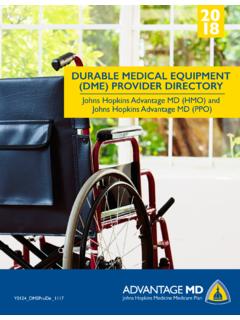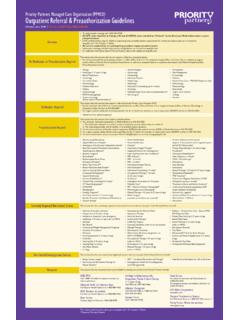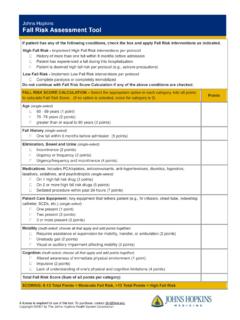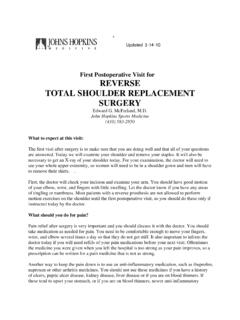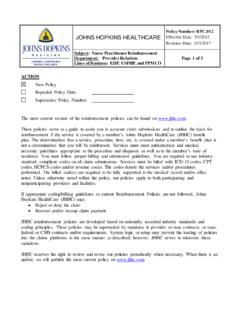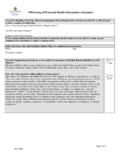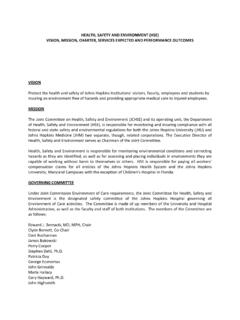Transcription of Swallowing Disorders: Introduction
1 Swallowing disorders : Introduction Swallowing is a complex function that affects the physical and mental health of all human beings. Not only does eating provide nutrients, but it also serves as important role in social interaction. The mechanism of Swallowing is a coordinated operation of the mouth, pharynx, and esophagus. Human beings swallow 600 times per day. Under normal circumstances, Swallowing is performed without thought or effort. Only the oral phase requires conscious effort. Once the bolus passes into the pharynx, involuntary reflexes serve to successfully pass it to the stomach. Dysphagia (from the Greek, "difficulty Swallowing ") refers to two related, but distinct, clinical problems.
2 On the one hand, it refers to a patient's awareness of impaired transit of swallowed oral contents. On the other, it refers more generally to any Swallowing disorder disorders that are often, but not always, associated with dysphagia. Swallowing disorders can present with a variety of symptoms other than dysphagia. The most common symptoms are swallow-related coughing and regurgitation of previously swallowed food or liquid (see Symptoms). disorders of Swallowing may result from problems with neural control, muscular coordination, inflammation, or neoplasia. Figure 1. Location of the pharynx, esophagus, and stomach in the body.
3 Clinical Specialties A large (and somewhat bewildering) number of clinical specialties are involved in the evaluation and management of Swallowing disorders . Table 1. Clinical Specialties Each of these specialties has it's own unique perspective on Swallowing disorders . However, there is considerable overlap in the types of disorders each specialty treats. As a result, it is often difficult to determine which specialty should be involved in the care of a particular patient. In more difficult or complicated situations, a multidisciplinary " Swallowing center" is often best equipped to coordinate a patient's evaluation and treatment.
4 Symptoms Swallowing disorders result in a variety of symptoms, which may occur in different combinations. In many cases, the temporal association of symptoms with Swallowing , or with meals, is obvious. In other cases, the association between Swallowing and symptoms may not be clear. Dysphagia Dysphagia refers to a patient's perception of difficulty in the passage of a swallowed bolus from mouth to stomach. Patients typically describe this as a sensation of food "sticking" in the throat or chest. They may also use the term "choking" (see below) to describe the same feeling. As previously mentioned, the term dysphagia can also be used to describe any Swallowing disorder, whether the symptom of dysphagia is present or not.
5 When used in this manner, the word refers to an entire category of disorders , rather than a single symptom. Although it is commonly assumed that patients can accurately localize dysphagia to the level of actual obstruction, this is not always the case (Figure 2). About one-third of patients identify a site well above the level of obstruction documented by radiographic studies. Distal localization (localization well below the level of obstruction), however, is rare. Figure 2. Localization of stricture; A, accurate; B, proximal. Coughing Coughing is a nonspecific response to a variety of stimuli usually originating in the pharynx, larynx, or lungs.
6 When coughing occurs during, or immediately after Swallowing , the symptom strongly suggests a Swallowing problem. However, because humans swallow throughout the day, patients may not recognize the temporal relationship of coughing to Swallowing . Also clouding this association is the fact that coughing may be due to premature leaking of oral contents into the pharynx, incomplete clearance of the bolus from the pharynx, or regurgitation of esophageal contents back to the pharynx (Figure 3). The term "choking" is frequently used to refer to coughing, or to a sensation of food sticking, rather than to coughing. Figure 3.
7 A food bolus penetrating the airway. Choking As mentioned above (see Dysphagia and Coughing), "choking" is a term frequently used by patients (and occasionally by physicians) to describe the feeling of food sticking in the esophagus or coughing. Although both symptoms may occur in patients with Swallowing disorders , they imply somewhat different mechanisms of dysfunction. In analyzing symptoms, it is therefore important to determine exactly what the patient means by the term. Regurgitation The Swallowing mechanism is designed to assure unidirectional movement of the swallowed bolus. "Regurgitation" refers to the return of food or liquid back to the mouth or pharynx, after it has apparently successfully passed out of either region (Figure 4).
8 Figure 4. Regurgitation of a food bolus. With regurgitation, material returns effortlessly to the mouth or throat. This contrasts with vomiting, during which nausea and retching are frequently present and contraction of the abdominal muscles and diaphragm play an important role. When patients suggest that the regurgitated material tastes like ingested food, a Swallowing disorder is usually present. Regurgitation of sour or bitter-tasting food or liquid suggests that at least some of the regurgitated material had reached the stomach. When sour or bitter regurgitation is present, the problem may fall within the spectrum of gastroesophageal reflux disease ( gerd ), rather than a Swallowing disorder.
9 Nasal Regurgitation The nasopharynx closes through a combination of soft palate elevation and contraction of the upper pharyngeal constrictor muscles (the superior pharyngeal constrictors). Failure of this closure mechanism, pharyngeal retention, or esophagopharyngeal regurgitation can result in nasal regurgitation (Figure 5). Figure 5. Nasal regurgitation of a food bolus. Other Symptoms Depending on the type of Swallowing disorder, patients may present with a sore throat, hoarseness, shortness of breath, and chest discomfort or pain. The relationship between Swallowing and these symptoms may not be obvious.
10 All of these symptoms may arise from a variety of other sources and none are specific to Swallowing disorders . Copyright 2001-2013 | All Rights Reserved. 600 North Wolfe Street, Baltimore, Maryland 21287. Swallowing disorders : Anatomy Physiology of Swallowing Normal Swallowing requires the coordinated activity of the oral cavity, pharynx, and esophagus. A properly functioning Swallowing mechanism provides efficient, unidirectional flow of the ingested bolus, while avoiding undesired diversion into the nasal cavity or respiratory tree. Between swallows, the pharynx and esophagus are at rest. The nasal cavity and larynx are in open communication with the pharynx permitting the individual to breathe freely.
